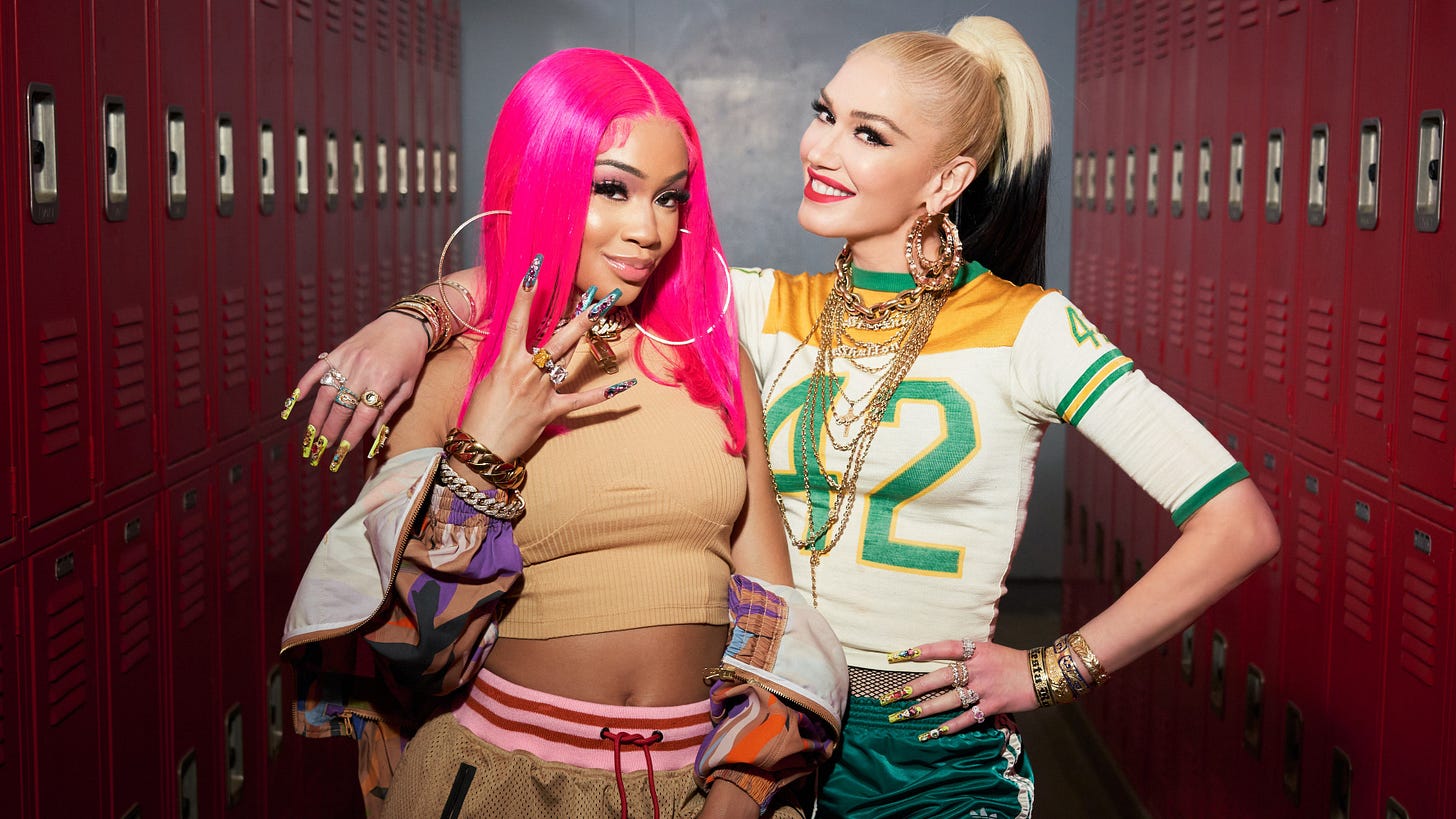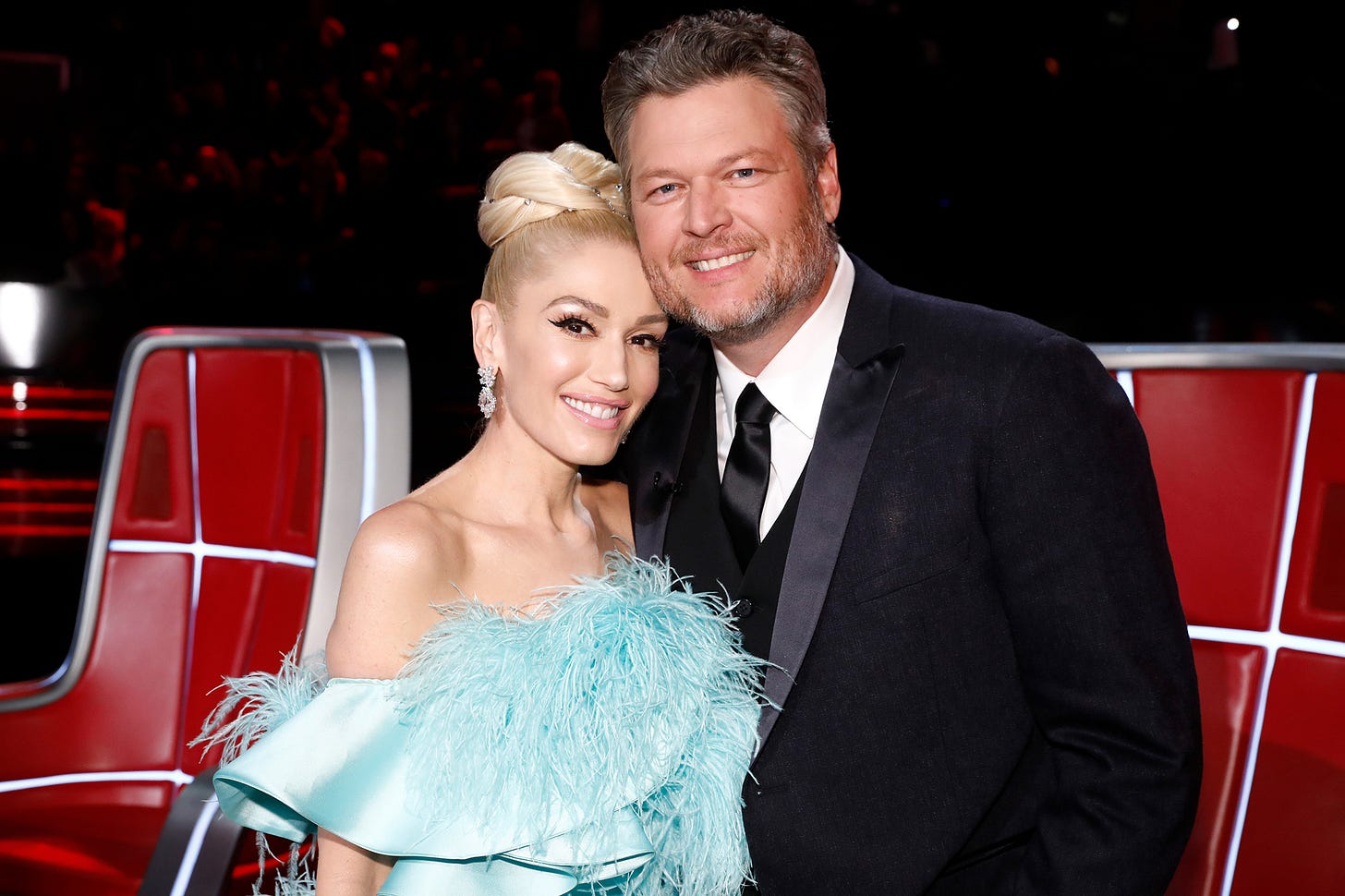
What if I told you that the Gwen Stefani you knew and loved is long gone, replaced in 2014 by a lookalike doppelgänger who is also, possibly, a robot comprised of some of the most advanced artificial intelligence the world has ever seen — just not advanced enough to have a songwriting chip implant. Would you believe me if I said that the real Gwen has been stashed away in a basement, furnished and decorated on the dime of one Blake Shelton, who flew in Chip and Joanna Gaines to consult for the bunker’s interiors? Buried underground, under one hundred feet of dirt and encased in the world’s finest soundproof steel, the real Gwen Stefani sits trapped in her multimillion-dollar luxury prison, writing and producing pop-punk hits that will never see the light of day while the country star who controls her estate signs another ten-year contract with Target Corporation to have her songs played on a wall of televisions in stores nationwide?
This is all speculation, of course. I can’t verify any of that. But anyone who has been paying attention to Stefani’s career over the last few years would likely be inclined to agree with me. The woman behind L.A.M.B. seems to be on the lamb, making a sweet escape from relevancy. There’s no other way to explain the discrepancy in quality between something like “Cool” and Stefani’s latest jump scare, “Slow Clap.” Last month, I dedicated a portion of the Monday letter to questioning Stefani’s steep (and reasonably fast) decline. It’s one of the greatest mysteries of our time. Stefani is responsible for some of the most prolific pop hits of the 21st century. Songs like “Cool,” “Hollaback Girl,” “Wind It Up,” and “The Sweet Escape” defined a generation of early aughts kids’ musical taste. Album cuts like “Bubble Pop Electric” and “Yummy” are clear throughlines to the textures and tempos that appear in the work of visionary PC Music artists like A.G. Cook, SOPHIE, and Danny L Harle. Stefani was one of the ultimate cool girls of the 90s who managed to not only keep that momentum going into the new millennium but ramp it up for the radio several years into a new decade. Stefani made floating from Ska Songstress to Punk Princess to Pop Powerhouse seem entirely effortless. So why, now, has she taken a sharp left turn into Hannah Montana territory?
“Slow Clap,” which was released in March and just updated with a second version and accompanying video that both feature rapidly-rising star Saweetie, is an enigma. And like all good enigmas (the Bermuda Triangle, Stonehenge, Lady Gaga’s much-memed wackadoo Vegas residency), it’s as inexplicably confounding as it is fascinating. One can’t help but wonder how Stefani found herself here, practically begging for relevance with a last-ditch, tacked-on feature and a detestable singalong chorus that wouldn’t even sound good at a honky-tonk square dance after eight whiskeys and a concussion from bull-ropin’.
Maybe it was all part of Stefani’s plan. Bad press is worse than no press at all? Because no press is exactly what “Slow Clap” garnered until Saweetie joined the song, which immediately set Twitter ablaze with people dunking on the song and video, calling it a bonafide back-to-school sale ad from the likes of Old Navy or JCPenney. As a former Old Navy employee, I can almost ensure you “Slow Clap” would’ve been added to the new monthly playlist we received from corporate, and I would’ve regretted my decision to keep on living every time it came on while I was folding clothes.


For an artist who maintained major success by reinventing herself just enough with every new album and era, Gwen Stefani has been noticeably stuck in a rut, one filled to the brim with her own brand of nauseating kitsch. Since she joined The Voice as a judge in April of 2014, Stefani’s career has been cruising on the fumes of nostalgia while she herself is high on the love she found on set in fellow judge Blake Shelton, the world’s most nauseatingly boring household name. Much to the chagrin of, well, everyone, it seems his brand of monotone mundanity has rubbed off on Stefani and her music. Stylistic references that used to seem meticulously curated and appropriately manicured, like the play on Alice in Wonderland in the “What You Waiting For” video or the nods to The Sound of Music in “Wind It Up,” have been replaced with garishly bright colors and shoehorned iconography. The Gwen Stefani of 2021 is stuck in the last decade, the equivalent of bacon-flavored vodka, mustache finger tattoos, and iron-on pepperoni pizza patches. There’s no symbolism, no themes, no message, and nothing interesting left to say.

Gwen flailing around a high school gymnasium feels decidedly humdrum, especially at a time in her life when there is so much potential for growth as an artist. She turned 51 last October, is raising three kids with her ex-husband, and is coming up on 30 years in the industry. There are hints of those trials here, but lyrics like, “Been the champion, rang the bell/Rocked the bottom, been through hell” get muddled among trite, cutesy filler lines like, “I’m the ice cream, you’re just the diet.” When Madonna turned 51 in 2010, she was just coming off Hard Candy, a bold late-period record for which the star was consistently shamed by ageist media. Yet despite it all, Madonna showed the world that at 51, she was not only capable of making some of the best dance hits of her career but penning some of her most devastatingly resonating midtempos as well, ones that have become career peaks over a decade later. Every artist is different, and to borrow a phrase from Madonna, it’s admittedly a little reductive for me to even compare the two women. But it just feels like there should be more for Gwen Stefani to say at this point, especially when she spent so much of her first two albums making deceptively introspective earworms.
I’m not saying Gwen Stefani needs to relegate herself to midtempos and ballads to find success at this stage of her career, it’s just that neither her sound nor her visuals feel appropriately polished for the amount of time she has spent in the industry creating iconic art. Post 2014-Gwen is the poster girl for throwing things at the wall and seeing what sticks. Problem is, nothing ever does. Gwen scrapped her original third record that included two great singles, “Baby Don’t Lie” and “Spark The Fire,” in favor of a more “mature” sound on This Is What the Truth Feels Like. The problem is, any dedicated Gwen Stefani fan could hear her struggling to find her place on that record between two decades of proven success and the desperation to do something new while still replicating the same mass adoration from the public. Instead of going against the grain like she had done her entire career, Stefani caved, making a record full of dull adult-contemporary pop songs that sounded aged the moment they were released in 2016.
So where does that leave us? And more importantly, where does that leave Gwen Stefani? With an as-yet-untitled but still apparently on-track fourth solo record due sometime this year, do we just give up? To be honest, it sort of seems like she already has. Is there any reason to hold out hope for the return of the Gwen from days of yore, hopefully without the cultural appropriation she built her solo career on? I wish I had a perfect answer, but I don’t. What I do know is that it’s not worth writing off any woman in pop. Even artists who briefly fell out of my personal favor have managed to keep me on my toes, making records that have been extraordinarily surprising. Lily Allen went from Sheezus to No Shame. Christina Aguilera went from Lotus to Liberation. Britney Spears went from Britney Jean to Glory! I believe that there may be hope for Gwen Stefani yet, if only Blake Shelton would unlock the bunker.




